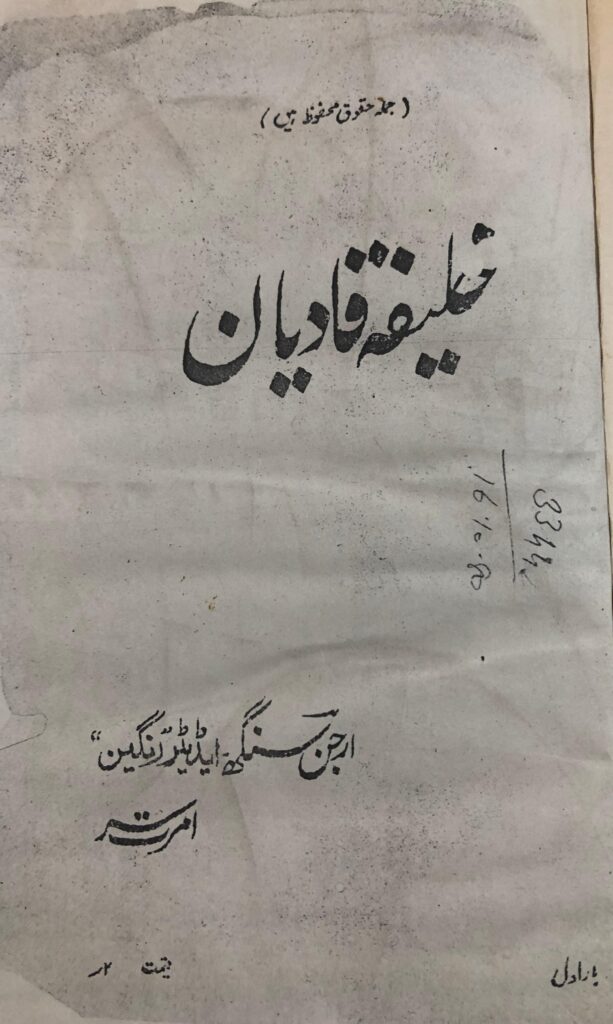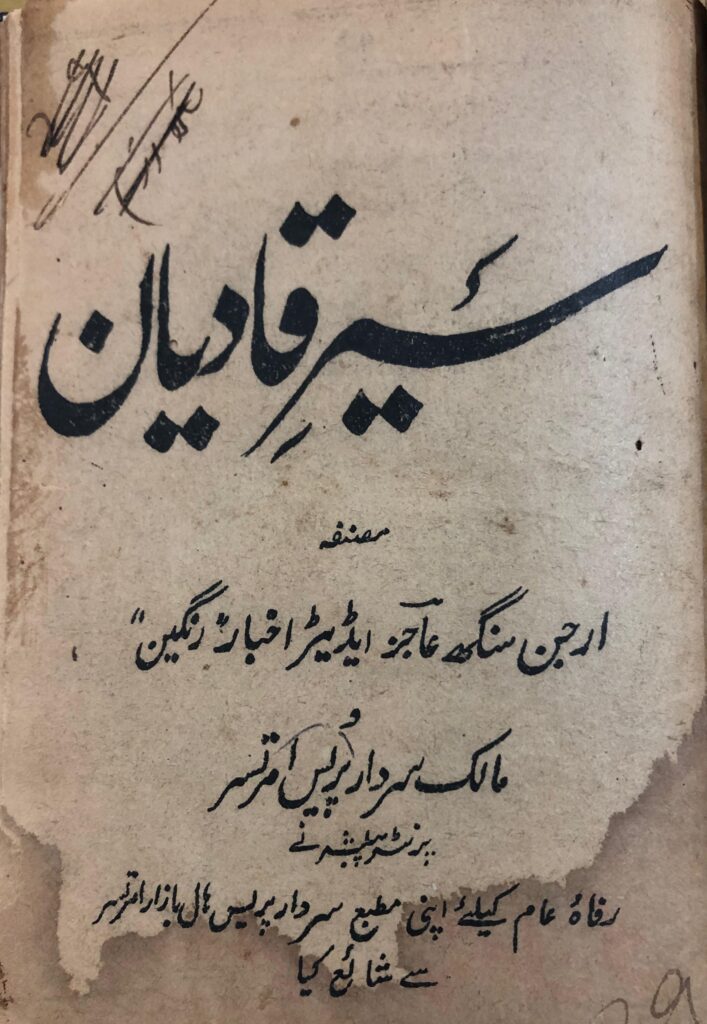Awwab Saad Hayat, Al Hakam
In British India, there was a non-Muslim journalist named Arjun Singh who added the word “Ajiz” to his name and published his newspaper from Amritsar, which he called Rangeen. This journalist was also the owner and publisher of Sardar Press Amritsar, located in the famous Hall Bazaar of Amritsar city. In addition to his writings about the Ahmadiyya Muslim Jamaat, he attempted to present glimpses of the life and achievements of Hazrat Mirza Bashir-ud-Din Mahmud Ahmad, Hazrat Musleh-e-Maudra, in a concise booklet in Urdu titled Khalifa-e-Qadian (Khalifa of Qadian).
Another work of Arjun Singh is titled Sair-e-Qadian – A Journey to Qadian. However, it is not evident from this book how many times or when exactly he visited Qadian. Nevertheless, based on his association with Qadian and his residing in the neighbouring city of Amritsar, along with the contents of this book, it can be inferred that his observations about Qadian were not merely based on others’ reporting. In his aforementioned book, Khalifa-e-Qadian, he recalls watching Hazrat Musleh-e-Maud’sra entourage during the famous court case of Syed Ataullah Shah Bukhari in March 1935.

There is no specific information regarding the year of its authorship or publication. Still, judging from the contents of the book, it can be speculated that it was written around the year 1935.
Below are some excerpts from this book that, upon reading, can provide an estimation of the high and exemplary standards of life in the sacred town of Qadian, the birthplace, residence, and final resting place of the Promised Messiahas. The established ideal society of the Ahmadiyya Muslim Jamaat in this sacred town showcases mutual brotherhood and remarkable human progress, which even a non-Muslim can appreciate. The book highly praises the extraordinary development and excellent management of this town, along with the exemplary moral conduct of its residents.
This book is beneficial as it reveals how the place referred to as an “unknown village” emerged as a blossoming garden and began to shine across the world due to its status as the abode of peace. This made people from all walks of life, both natives and strangers, unable to resist their curiosity and fascination for the lives, habits, inclinations, and ethics of the inhabitants of Qadian.
Arjun Singh Sahib writes:
“Go to Qadian. There, you will see schools, madrasas, and educational institutions for both men and women. It is astonishing that while in other Muslim areas, elders discouraged Muslims from acquiring knowledge and especially learning English, in Qadian, the esteemed elders themselves made arrangements for learning English. They even laid the foundation for enlightening girls with pearls of knowledge. As a result, in Qadian’s women’s schools, hundreds of girls are acquiring education.
“Offices are functioning smoothly with established procedures. There is a department for preaching and propagation and another for education. Some are responsible for internal affairs, while others oversee external affairs, and all these departments are supervised by a senior administrator who looks after their management. In each department, there are several clerks. This well-organised system of Qadian demonstrates that their leader, the Khalifa, is a highly esteemed individual.” (Sair-e-Qadian – A Journey to Qadian, pp. 8-9)
Afterwards, the author writes with great enthusiasm about the exceptional and high standards of obedience of the members of the Community, the central leadership within the Community, and other positive aspects. The author suggests that all Indians should take a lesson from this. If the entire country came under one leadership, India could truly become a paradise, and all conflicts would cease, resulting in a unified and peaceful life.
The author then, under the title “Qadiani Properties,” provides information based on his research:
“The Ahmadiyya Community possesses properties worth millions of rupees. They have a separate department for managing these properties. Although most people in Qadian also have private properties, the Ahmadiyya Community has substantial properties that could be sold for hundreds and thousands of rupees. All the offices, schools, and institutions in Qadian are the property of the Community. Additionally, many villages in Sindh have a significant portion of their properties owned by the Ahmadiyya Community.
“It is also evident that in foreign countries where Ahmadi missions are established, most of the locations have Ahmadi-owned buildings. In many countries, the Ahmadi Community has constructed mosques as well.” (Ibid., p. 12)

Arjun Singh adds, “You would be astonished to know that thousands of men and women have bequeathed one-third of their properties to the Anjuman of the Ahmadiyya Jamaat. Hence, it can be said that the Ahmadiyya Jamaat’s ownership of properties worth crores of rupees is imminent in the near future. This trend of people bequeathing their properties to the Ahmadiyya Jamaat is ongoing, and it is an endless process.” (Ibid., p. 13)
In light of the domestic life of Ahmadis, the author writes that the Khalifa of the Ahmadiyya Jamaat also pays attention to Ahmadi’s domestic life and regularly issues instructions that lead to a content and happy life. For example, he mentioned that the Khalifa presented a programme in which one of the instructions was that regardless of being rich or poor, a leader or a commoner, no one should have more than one dish at their dining table. This command has been tested from both medical and economic aspects and has shown remarkable results. Furthermore, the Khalifa’s directive is to refrain from purchasing new jewellery for the next three years and avoid buying unnecessary clothes.
The author emphasised that the Khalifa’s directives not only promote simplicity and modesty but also have practical benefits for both the individual and the Community as a whole. The Khalifa’s attention to the smallest details of their domestic life showcases his concern for the well-being and prosperity of the Community.
As the book progresses, the author mentions Ahmadis’ political affiliations and discusses various political parties. For instance, concerning the Majlis-e-Ahrar, the author writes:
“Majlis-e-Ahrar, which claims to be unique in the world, has set aside all its previous principles just to engage in antagonistic activities against Ahmadis. Today, they desire to expel Ahmadi Muslims from Islam, and perhaps tomorrow, they will try to banish them from their homeland and subsequently from the rest of the world. However, we firmly believe that if there is any living group among Muslims, it is the Ahmadiyya Jamaat. As we have established before, the organisation and way of life of Ahmadis ensure their protection and safety.” (Ibid., p. 29)
He adds, “Furthermore, according to the study of Ahmadi newspapers, it becomes evident that ever since the Ahrar party intensified their campaign against Ahmadiyyat, the Ahmadi Community has been progressing day by day. As a result, their financial condition has improved significantly. Their administrative departments are currently working with increased efficiency, and there is hardly any idle time. Meanwhile, 10 to 15 individuals from among the Muslims are joining the Ahmadiyya Community on a regular basis.
“We have learned from some responsible Ahmadis that they consider the Ahrar Movement [due to their opposition] highly beneficial for the progress of their Community. They claim that the Ahrar’s efforts against Ahmadiyyat will never be successful, and instead, the Ahmadiyya Community will flourish. The Ahmadis believe that every time the Ahrar tries to suppress them, it only strengthens the Ahmadiyya Community and inflicts distress upon the Ahrar themselves. The Ahmadis are confident that their Community will emerge triumphant in such circumstances.’’ (Ibid., p. 30)
Arjan Singh Ajiz has written in his book about the differences in beliefs between Ahmadis and other Muslim sects. In this section, he briefly discusses the beliefs regarding God, angels, divine scriptures, belief in prophets, belief in the Day of Judgement, and the demise of Jesusas. He also touches upon the concepts of the finality of prophethood, the second advent of the Messiah, and the perspective of Jihad.
The purpose of including this material in the book is to present a comprehensive view of the Ahmadis’ beliefs to non-Muslims. Through this concise booklet, one can gain insight into the layout of the Ahmadiyya Markaz in Qadian and appreciate the beautiful analysis of the lives of Ahmadis.

